Regarding home renovations, the bathroom is one of the most frequently updated spaces. Whether it’s for aesthetic reasons or functionality, replacing your bathroom vanity can make a big difference in your bathroom’s overall look and feel, however, tackling such a project can be overwhelming for many homeowners, especially those who aren’t handy.
The good news is that with the right tools and some basic knowledge, replacing a bathroom vanity is a task that even the most novice DIYers can accomplish. We’ll walk you through the step-by-step process on how to replace a bathroom vanity.
We’ll cover everything from removing the old vanity to installing the new one. And also provide tips for choosing the right vanity for your space and offer guidance on making the most of your new bathroom feature.
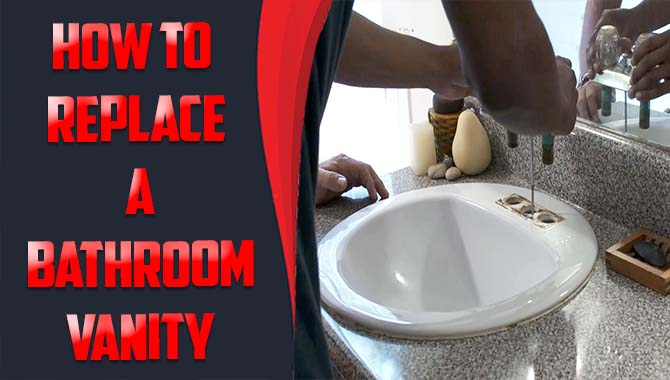
What Is A Bathroom Vanity?
A bathroom vanity is a piece of furniture that typically includes a sink and storage cabinets. It is designed to provide a functional and stylish solution for organizing bathroom essentials such as toiletries, towels, and cleaning supplies.
Bathroom vanities come in various styles, sizes, and materials to fit the design and layout of any bathroom. They can be wall-mounted or freestanding, with single or double sinks, and feature different countertops like granite or marble.
Some vanities include mirrors, lighting, and built-in electrical outlets. Ultimately, a bathroom vanity serves as an essential element in any bathroom space by providing both practical storage solutions and enhancing the overall aesthetic appeal of the room.
Tools Needed For Replacing A Bathroom Vanity
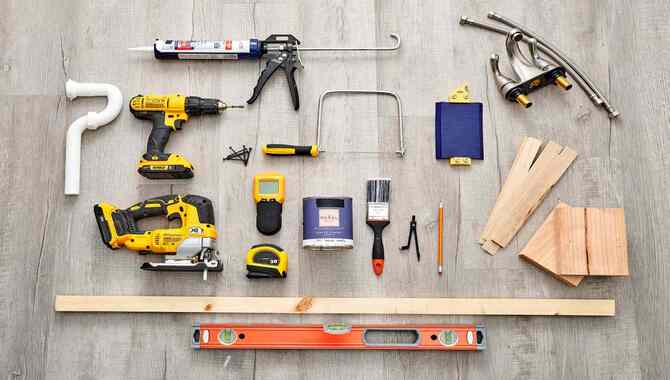
Replacing a bathroom vanity can seem daunting, but having the right tools on hand can make the process much easier. Here are some of the essential tools that you’ll need to replace a bathroom vanity successfully.
These tools will help you remove the old vanity, install the new one, and ensure everything is level and secure. Remember that different vanities may require additional or specialized tools, so be sure to do your research before starting your project. With the right tools and some know-how, you can have a brand-new bathroom vanity in no time.
- Driver (flathead and Phillips)
- Pliers
- Putty knife
- Level
- Power drill
- Hole saw
- Caulk gun
How To Replace A Bathroom Vanity: 6 Easy Ways
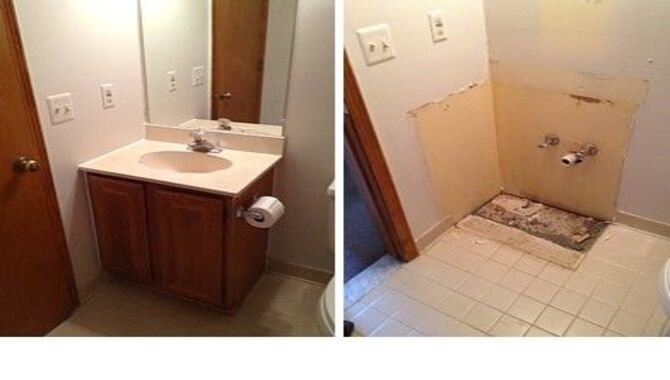
Replacing a bathroom vanity can be a great way to give your bathroom a fresh look. Whether you’re upgrading an old vanity or want to change the style of your bathroom, replacing the vanity is relatively simple and affordable, Still, it can be a simple DIY project with the right tools and some helpful tips. Here are six easy ways on how to replace a bathroom vanity:
- Turn off the water supply. Before you begin removing the old vanity, make sure to turn off the water supply to your sink.
- Remove the old vanity. Use a utility knife to cut through any caulk or adhesive holding the old vanity in place. Then, unscrew any screws holding it to the wall and carefully remove it.
- Install the new vanity top. Place the new vanity top on the base and use silicone adhesive to secure it.
- Install the faucet. Follow the manufacturer’s instructions to install your new faucet onto the sink.
- Attach plumbing fixtures. Connect your new sink’s drain and water supply lines to your home’s plumbing system.
- Finish up with caulk and accessories. Use caulk around the edges of your new vanity top to prevent water damage, then add finishing touches, such as backsplashes or mirrors.
By following these six steps, you can replace your bathroom vanity in no time and give your bathroom a fresh new look!
How To Choose Bathroom Vanities
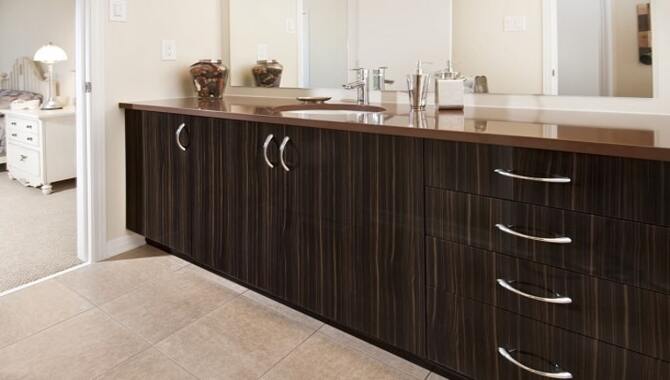
When shopping for new bathroom vanities, consider the size and layout of your bathroom carefully. Look for a vanity with ample storage space and choose a sink type that complements your decor, such as an under-mount or drop-in sink.
Selecting durable materials like wood or stone is crucial while keeping the installation process in mind. Hiring a plumber is best if you’re not confident in your DIY skills.
Types Of Vanities
When replacing a bathroom vanity, there are several types to choose from. The most common vanities are freestanding, wall-mounted, and corner. Freestanding vanities are the most traditional, with a cabinet on the floor and a countertop attached to the top.
Wall-mounted vanities are becoming increasingly popular due to their sleek and modern appearance. These vanities attach directly to the wall, which frees up floor space and makes cleaning the bathroom more accessible.
Corner vanities are designed for smaller bathrooms or spaces where you want to maximize storage without taking up too much room. These vanities fit snugly into a corner and are usually triangular to maximize storage space. When choosing a vanity type, consider your bathroom’s layout, size, and style to determine which option will work best for your needs.
Diy Or Hire A Plumber?
Whether to DIY or hire a plumber for a bathroom vanity replacement depends on your plumbing skills and comfort level. DIY saves money but demands time and effort while hiring a pro ensures proper installation and peace of mind.
Consider project complexity, budget, and timeline before deciding. Always measure carefully and choose a vanity that fits your bathroom space and style, regardless of your choice.
What To Do If Your Bathroom Vanity Is Damaged
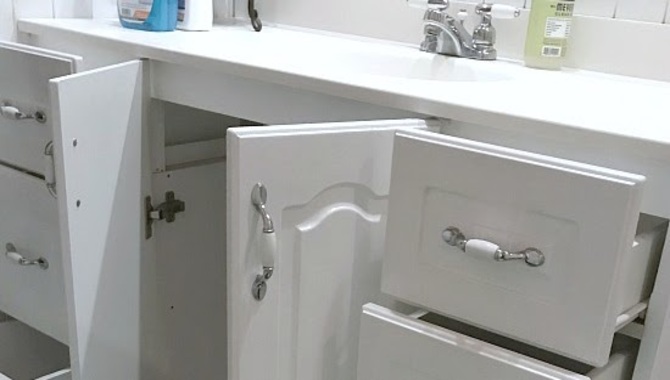
When your bathroom vanity is damaged, turn off the water valves and disconnect the supply lines. Pry off the countertop and sink faucet, then unscrew and remove any mounting hardware. Remove the old vanity carefully to avoid damaging the flooring or walls. Next, scrape any remaining adhesive or sealant from the wall studs using a putty knife or utility knife.
Prepare to install the new bathroom vanity by measuring its width and cutting any necessary holes for plumbing access. Follow the manufacturer’s instructions while installing a new sink faucet, drain trap, and P-trap. Finally, adjust the shims under the legs of your vanity if needed to level it on an uneven floor surface.
Tips For Installing A New Bathroom Vanity
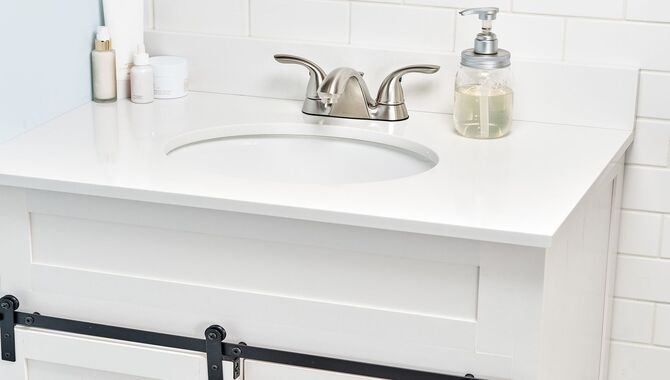
Installing a new bathroom vanity can be a great way to update your bathroom and give it a fresh look. However, the installation process can be tricky if you’re unfamiliar with plumbing or carpentry. Here are some tips to help you successfully install your new bathroom vanity:
- Measure twice, cut once. Make sure you measure the space where you will install the vanity and double-check your measurements before making any cuts.
- Turn off the water supply. Before beginning any plumbing work, turn off the water supply to prevent leaks or flooding.
- Use proper tools. Ensure that you have all the necessary tools, such as a drill, level, and pipe wrenches, to ensure the installation goes smoothly.
- Follow manufacturer instructions. Read and follow the manufacturer’s instructions carefully to ensure you install the vanity correctly and safely.
Preparing The Area
Properly preparing the area is crucial when installing a new bathroom vanity, removing the old vanity and fixtures, and measuring the space for a perfect fit. Ensure safety by turning off plumbing and electrical connections before work begins. Protect your floors and surrounding surfaces with materials like shims or putty.
Know Your Plumbing
Before choosing a new bathroom vanity, it’s essential to consider your plumbing connections. To avoid damage and leaks, ensure the new vanity is compatible with existing pipes and drain locations. If you’re unsure how to connect the new vanity to your plumbing system, consider hiring a plumber. Following the manufacturer’s instructions carefully will help ensure a successful installation.
Removing Old Vanity
To remove an old bathroom vanity, turn off the shutoff valves and disconnect the supply lines with wrenches. Remove any screws or bolts holding the vanity against the studs, and carefully lift them away from the wall.
Use a utility knife to cut through the caulk between the vanity top and the old backsplash. Clean up any remaining adhesive or debris before installing your new bathroom vanity according to the manufacturer’s instructions.
Measure And Mark Stud Locations
When installing a new bathroom vanity, it’s essential to take accurate measurements and mark stud locations on the wall. This will ensure that your new vanity fits appropriately and is securely mounted. Consider the location of existing plumbing fixtures when selecting a new vanity.
For proper installation, follow detailed instructions from the manufacturer or hire a professional plumber. Use shims, putty, silicone, or sealant to prevent leaks and secure the vanity top. Following these tips, you can install your new bathroom vanity and enjoy a refreshed and updated bathroom space.
Things To Keep In Mind While Buying A New Bathroom Vanity
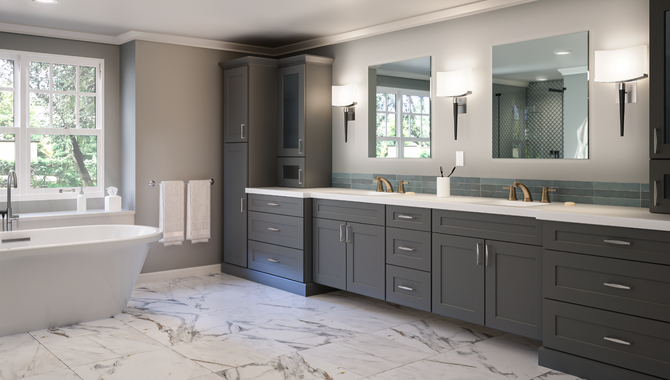
When buying a new bathroom vanity, you should keep a few things in mind to ensure that you make the right choice. First and foremost, consider the size of your bathroom and the space available for the vanity. You want to ensure your new vanity is not too big or too small for your bathroom.
Next, think about your storage needs. Do you need much storage space for towels, toiletries, and other bathroom essentials? If so, look for a vanity with ample storage options, such as drawers and cabinets. Consider the style of your bathroom as well.
Do you prefer a modern look or something more traditional? This can help guide your decision on the type of vanity to choose. Finally, think about the materials used in the construction of the vanity. Ensure they are durable and will hold up well in a damp environment like a bathroom.
By keeping these factors in mind while shopping for a new bathroom vanity, you can be sure that you make an informed decision that meets all of your needs and enhances your bathroom’s overall look and functionality.
Conclusion
Replacing a bathroom vanity can be a simple DIY project to give your bathroom a much-needed facelift. However, knowing how to replace a bathroom vanity and having the right tools for the job is essential. Whether you hire a professional or do it yourself, ensure you have all the necessary information before starting.
Consider size, style, and functionality when choosing a new bathroom vanity. Remember any plumbing requirements and if you need to make any adjustments to the existing plumbing. Remember to take your time, measure carefully, and be patient – the result will be worth the effort. If you’re unsure about any steps, it’s always best to consult a professional to ensure the job is done correctly and safely.
Frequently Asked Questions
[rank_math_rich_snippet id=”s-cd64d481-2ad3-42d2-a7e0-9db2994f1e00″]

I am passionate about home engineering. I specialize in designing, installing, and maintaining heating, ventilation, and air conditioning systems. My goal is to help people stay comfortable in their homes all year long.
